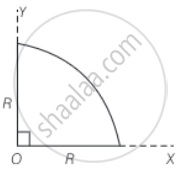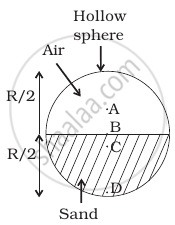Advertisements
Advertisements
प्रश्न
Find the centre of mass of a uniform (a) half-disc, (b) quarter-disc.
उत्तर
Let M and R be the mass and radius of the half-disc, mass per unit area of the half-disc

(a) The half-disc can be supposed to be consists of a large number of semicircular rings of mass om and thickness and radii ranging from r = 0 to r = R.
The surface area of the semicircular ring of radius r and of thickness dr = `1/2 2πr xx dr = πrdr`
∴ Mass of this elementary ring, dm = `πrdr xx (2M)/(rR^2)`
dm = `(2M)/R^2 rdr`
If (x, y) are coordinates of the centre of mass of this element,
Then, `(x, y) = (0, (2r)/π)`
Therefore, x = 0 and y = `(2r)/π`
Let xCM and yCM be the coordinates of the centre of mass of the semicircular disc.
Then xCM = `1/M int_0^R xdm = 1/M int_0^R 0 dm = 0`
yCM = `1/M int_0^R ydm = 1/M int_0^R (2r)/π xx ((2M)/R^2 rdr)`
= `4/(πR^2) int_0^R r^2dr`
= `4/(πR^2) [r^3/3]_0^R`
= `4/(πR^2) xx (R^3/3 - 0)`
= `(4R)/(3π)`
∴ Centre of mass of the semicircular disc = `(0, (4R)/(3π))`
(b) Centre of mass of a uniform quarter disc.

Mass per unit area of the quarter disc = `M/((πR^2)/4) = (4M)/(πR^2)`
Using symmetry
For a half-disc along the y-axis centre of mass will be at `x = (4R)/(3π)`
For a half-disc along the x-axis centre of mass will be at `x = (4R)/(3π)`
Hence, for the quarter disc centre of mass = `((4R)/(3π), (4R)/(3π))`
APPEARS IN
संबंधित प्रश्न
The centre of mass is defined as \[\vec{R} = \frac{1}{M} \sum_i m_i \vec{r_i}\]. Suppose we define "centre of charge" as \[\vec{R}_c = \frac{1}{Q} \sum_i q_i \vec{r_i}\] where qi represents the ith charge placed at \[\vec{r}_i\] and Q is the total charge of the system.
(a) Can the centre of charge of a two-charge system be outside the line segment joining the charges?
(b) If all the charges of a system are in X-Y plane, is it necessary that the centre of charge be in X-Y plane?
(c) If all the charges of a system lie in a cube, is it necessary that the centre of charge be in the cube?
You are holding a cage containing a bird. Do you have to make less effort if the bird flies from its position in the cage and manages to stay in the middle without touching the walls of the cage? Does it makes a difference whether the cage is completely closed or it has rods to let air pass?
A high-jumper successfully clears the bar. Is it possible that his centre of mass crossed the bar from below it? Try it with appropriate figures.
A railroad car of mass M is at rest on frictionless rails when a man of mass m starts moving on the car towards the engine. If the car recoils with a speed v backward on the rails, with what velocity is the man approaching the engine?
Solve the following problem.
Four uniform solid cubes of edges 10 cm, 20 cm, 30 cm and 40 cm are kept on the ground, touching each other in order. Locate centre of mass of their system.
Find out the centre of mass for the given geometrical structures.
a) Equilateral triangle
b) Cylinder
c) Square
The centre of mass of a system of two particles divides the distance between them ______.
Which of the following has maximum momentum?
Centre of mass is a point ______.
Which of the following points is the likely position of the centre of mass of the system shown in figure?

